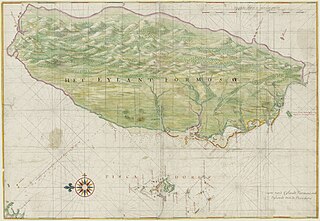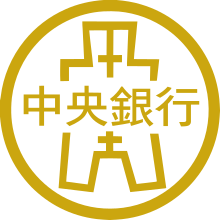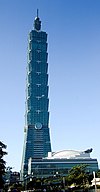The Three Links or Three Linkages was a 1979 proposal from the National People's Congress of the People's Republic of China (PRC) to open up postal, transportation, and trade links between Mainland China and Taiwan, with the goal of unifying Mainland China and Taiwan.

The Bank of China is a Chinese majority state-owned commercial bank headquartered in Beijing and one of the very largest banks in the world.
The New Taiwan dollar is the official currency of the Republic of China. The New Taiwan dollar has been the currency of the island of Taiwan since 1949, when it replaced the old Taiwan dollar, at a rate of 40,000 old dollars per one new dollar. The basic unit of the New Taiwan dollar is called a yuan (圓) and is subdivided into ten chiao (角), and into 100 fen (分) or cents, although in practice both chiao and fen are never actually used.

As a result of the surrender and occupation of Japan at the end of World War II, the islands of Taiwan and Penghu were placed under the governance of the Republic of China (ROC), ruled by the Kuomintang (KMT), on 25 October 1945. Following the February 28 massacre in 1947, martial law was declared in 1949 by the Governor of Taiwan, Chen Cheng, and the ROC Ministry of National Defense. Following the end of the Chinese Civil War in 1949, the ROC government retreated from the mainland as the Chinese Communist Party (CCP) proclaimed the establishment of the People's Republic of China. The KMT retreated to Taiwan and declared Taipei the temporary capital of the ROC. For many years, the ROC and PRC each continued to claim in the diplomatic arena to be the sole legitimate government of "China". In 1971, the United Nations expelled the ROC and replaced it with the PRC.

Bank of Communications is the fifth-largest bank in mainland China. It was originally established in 1908 and was one of a handful of domestic Chinese banks that issued banknotes in modern history. Following the Chinese Communist Revolution in 1949, the mainland operation of that bank were merged into the People's Bank of China and People's Construction Bank of China under the Communist single-tier banking system, while its continuation in Taiwan eventually became part of Mega International Commercial Bank.

The Bank of Taiwan is a commercial bank headquartered in Taipei, Taiwan. It was the main issuer of banknotes on the island from 1899 to 1961, when that role was taken over by the Central Bank of China (now Central Bank of the Republic of China. The Bank of Taiwan is owned by the Government of the Republic of China.

The history of Chinese currency spans more than 3000 years. Currency of some type has been used in China since the Neolithic age which can be traced back to between 3000 and 4500 years ago. Cowry shells are believed to have been the earliest form of currency used in Central China, and were used during the Neolithic period.
The Central Engraving and Printing Plant, known in English before 2003 as the China Engraving and Printing Works (CEPW), is a subsidiary of the Central Bank of the Republic of China (Taiwan). It is responsible for printing the paper bank notes of Taiwan in its currency, the New Taiwan dollar.
The Old Taiwan dollar was in use from 1946 to 1949, beginning shortly after Taiwan's handover from Japan to the Republic of China. The currency was issued by the Bank of Taiwan. Hyperinflation prompted the introduction of the New Taiwan dollar in June 1949, shortly before the Nationalist evacuation from mainland China in December.

The Central Mint, known in English before 2004 as the Central Mint of China (CMC), is a subsidiary company of the Central Bank of the Republic of China (Taiwan). The major activities of the mint are minting and melting circulation and commemorative coins, and producing commemorative medals and other kind of casting products for government institutions and businesses in Taiwan.

The Shanghai Commercial and Savings Bank is a bank of the Republic of China, currently based in Taipei, Taiwan.

The Farmers Bank of China was a Chinese bank founded on April 1, 1933, in Hankou from the amalgamation of provincial agricultural banks in Henan, Hubei, Anhui and Jiangxi. Governed by the Farmers Bank of China Law, the bank was established to stimulate agricultural development by providing lines of credit to farmers and rural landowners. The loans were intended for use to purchase equipment and crops. The bank was initially under majority government ownership.

The cross-strait charters are special flights between Taiwan and mainland China, across the Taiwan Strait. After the Chinese Civil War, no direct flights were allowed between Taiwan and mainland China; this remained the case until 2003. Passengers had to transfer in a third city, such as Hong Kong, to complete their trip.
The history of banking in China includes the business of dealing with money and credit transactions in China.
The fifth series of the new Taiwan dollar banknotes is the current and latest series to be issued for circulation in the Republic of China (Taiwan). It was first introduced by the Central Bank of the Republic of China (Taiwan) on 3 July 2000.

The Republic of China (ROC), or simply China, was a sovereign state based on mainland China from 1912 to 1949 prior to the government's relocation to Taiwan, where it continues to be based today. The ROC was established on 1 January 1912 during the Xinhai Revolution against the Qing dynasty, ending the imperial history of China. The Republican government was ruled by the Kuomintang (KMT) as a one-party state based in Nanjing from 1927, until its flight to Taipei on 7 December 1949 following the KMT's de facto defeat by the Chinese Communist Party (CCP) in the Chinese Civil War. The CCP proclaimed the People's Republic of China on 1 October 1949, while the ROC retains control over the "Free Area", with the political status of Taiwan remaining in dispute to this day.
The administrative divisions of China between 1912 and 1949 were established under the regime of the Republic of China government.

The retreat of the government of Republic of China to Taiwan, also known as the Kuomintang's retreat to Taiwan or the Great Retreat in Taiwan, refers to the exodus of the remnants of the then-internationally-recognized Kuomintang-ruled government of the Republic of China (ROC) to the island of Taiwan (Formosa) on December 7, 1949, after losing the Chinese Civil War in the Chinese mainland. The Kuomintang, its officers, and approximately 2 million ROC troops took part in the retreat, in addition to many civilians and refugees, fleeing the advance of the People's Liberation Army of the Chinese Communist Party (CCP). The CCP, who now effectively controlled most of Mainland China, spent the subsequent years purging any remnant Nationalist agents and bandits in western and southern China, solidifying the rule of the newly established People's Republic of China.

The Chinese gold yuan was a legal tender currency of China between August 1948 and 1949. It was a method used by the Republic of China government to accumulate gold from its citizens in preparation to relocate to Taiwan. It circulated in the country under the effective control of the Government of the Republic of China known as Taiwan Province, R.O.C., which issued paper money on August 19, 1948. This currency was notorious for vicious inflation due to inadequate issuance preparation and failure to strictly enforce issuance limits. In the early days of the issuance of the Golden yuan, the government used executive actions to force the public to exchange gold, foreign currency for the new currency. The legal exchange rate was 0.22217 grams of gold per gold yuan but it could not be honored. The sharply depreciating Fabi currency was at the rate of one golden yuan of the yen to Fabi $3 million, and this rate was used for the compulsory collection of public gold, silver, and foreign currency. In particular, the economic losses suffered by the urban middle class were so great that the ROC government lost its original most important supporters and was one of the reasons why the ROC government failed so quickly in the Chinese Civil War.





















